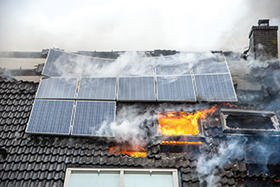

Installed global solar capacity doubled in three years from 2018, and the expectation is that in the next three years, it will more than double (www.solarpowereurope.org). In South Africa, the year-on-year growth from
With this increase in global solar growth, there stands to reason that there will be an increase in fires associated with solar installations. Currently, there is a severe lack of data on the prevalence of solar installation fires. However, a quick look at some headlines reported in the news globally clearly indicates they are occurring with frequency and causing significant damage.
• Solar panel fire season is all year round, and it’s getting more intense in Australia. The Conversation. Published: January 6, 20211.
• Amazon took all US solar rooftops offline last year after a flurry of fires, electrical explosions. CNBC. Published September 1, 20222.
• Flames at Vodacom: The fire risks that come with solar panels. The Citizen, published July 12, 20233.
Available data indicates that fires in solar installations can originate in the photovoltaic (PV) solar panels and connections, the associated inverter and battery storage (if installed). PV solar panel fires are typically caused by poor installations, ground faults, DC arcing, maintenance operations, roof debris, animal nests, physical damage, or the panel overheating.
FM Global has recognised the increasing risks associated with PV solar panel fires and published loss prevention guidance sheets as early as 2014, with recent updates in January 2023. The loss prevention guidance sheets both cover roof and ground-mounted solar panel installations and provide valuable information to help mitigate the abovementioned risks.
One specific recommendation is the installation of FM-approved linear heat detection, such as the Confirmed Temperature Initiation (CTI) Series Linear Heat Detector by Protectowire, on top of the roof cover and below the PV modules. One line of heat detection can be placed within each sun-facing or east-west-facing row of PV panels.
Protectowire’s CTI Series Linear Heat Detector (LHD) is a fixed temperature detector designed to meet the detection challenges presented in solar panel installations. The CTI-220-XCR requires heat to generate an alarm condition; physical damage to the detector will not produce an alarm.
In addition, the Protectowire CTM-530 module has an integrated alarm point location to assist those responding to an alarm in determining the hotspot location. A fast response time can mean the difference between a controlled fire situation and a major recovery operation.
References
[1] www.securitysa.com/*solar1
[2] www.securitysa.com/*solar2
[3] www.securitysa.com/*solar3
| Tel: | +27 11 794 9144 |
| Email: | [email protected] |
| www: | www.technoswitch.co.za |
| Articles: | More information and articles about Technoswitch Fire Detection & Suppression |

© Technews Publishing (Pty) Ltd. | All Rights Reserved.